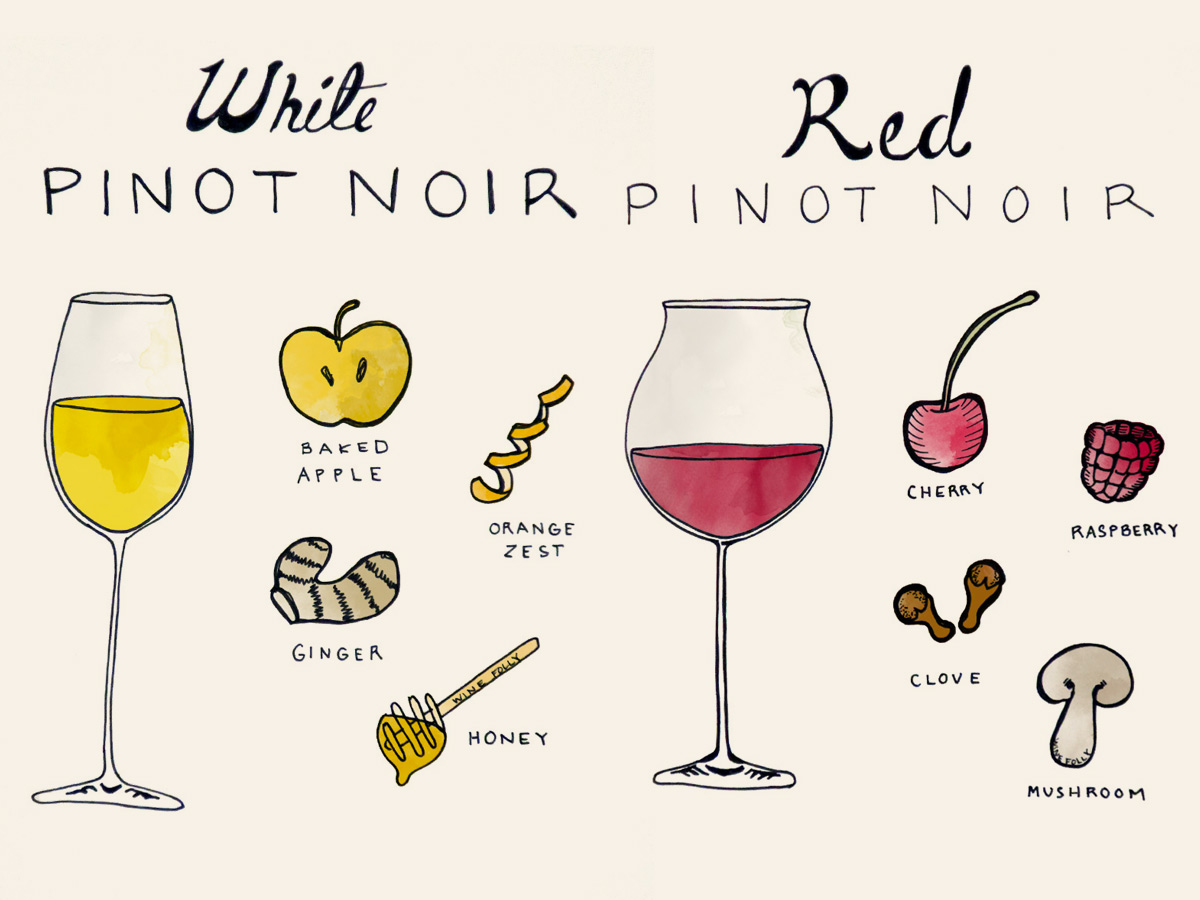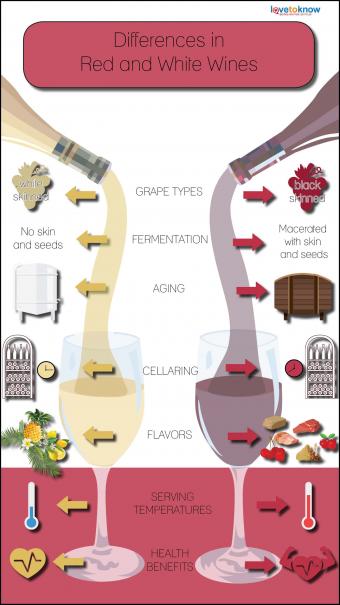Difference In Grapes Used For White And Red Wine

White wine is typically made from white grapes, or from the juice of red grapes that has been separated from the grape skins. Common white wine grape varieties include Chardonnay, Sauvignon Blanc, and Pinot Grigio. These grapes generally have lighter skin and are harvested earlier in the season.
On the other hand, red wine is made from dark-colored grapes, which include varieties such as Cabernet Sauvignon, Merlot, and Pinot Noir. The skins of these grapes are left in contact with the juice during fermentation, resulting in the red color and more robust flavors typically associated with red wine.
It is important to note that there are also grape varieties that can be used to make both white and red wine, such as the versatile grape, Pinot Noir. The choice of grapes used in winemaking plays a significant role in determining the flavor profile of each type of wine.
White Wine Grape Varieties
White wine is made from various grape varieties that contribute to its unique flavors and characteristics. Some of the popular white wine grape varieties include Chardonnay, known for its buttery and oaky flavors; Sauvignon Blanc, which offers a crisp and refreshing taste with notes of citrus and herbs; and Pinot Grigio, prized for its light and fruity profile. Other notable white wine grapes include Riesling, with its floral and sweet flavors, and Gewürztraminer, known for its aromatic and spicy notes. Each grape variety brings its own distinct qualities to white wine, providing a wide range of options for wine enthusiasts.
Red Wine Grape Varieties
Red wine is made from a variety of grape varieties, each contributing its own unique flavors and characteristics. Some of the most popular red wine grape varieties include Cabernet Sauvignon, known for its boldness and tannic structure; Merlot, which offers a softer and fruit-forward profile; Pinot Noir, prized for its delicate and earthy notes; and Syrah/Shiraz, known for its richness and spice. Other notable red wine grapes include Malbec, Zinfandel, and Sangiovese. Each grape variety brings its own distinct qualities to red wine, providing a wide range of options for wine enthusiasts to explore and enjoy.
Production Process Of White And Red Wine

White wine and red wine differ in their production processes. White wine is made by gently pressing the grapes and fermenting only the juice, while red wine undergoes a process called maceration. In maceration, the grape skins are left in contact with the juice during fermentation, resulting in the extraction of color, tannins, and flavor compounds. After fermentation, white wines are typically aged in stainless steel tanks or oak barrels, while red wines often undergo further aging in oak barrels to enhance their flavors and aromas. This distinct production process contributes to the different characteristics and profiles of white and red wines.
White Wine Making Process
The white wine making process begins with the gentle pressing of the grapes to extract the juice. The grape skins, seeds, and stems are separated from the juice, and fermentation takes place using either ambient or cultured yeast. The fermentation process converts the sugar in the juice into alcohol, resulting in the formation of white wine. After fermentation, the wine is typically aged in stainless steel tanks or oak barrels to enhance its flavor and aroma. The aging period can range from a few months to several years, depending on the desired characteristics of the wine. Finally, the wine is clarified, filtered, and bottled, ready to be enjoyed.
Red Wine Making Process
The production process of red wine differs from that of white wine in several ways. After the grapes are harvested, they are crushed to extract both the juice and the skins. The skin provides the red color and tannins to the wine. The juice and skins are then fermented together for a period of time, usually longer than white wine, to allow for full extraction of color, flavor, and tannins. The wine is then aged in oak barrels, which adds additional complexity and flavor. Finally, the wine is clarified, filtered, and bottled, ready to be enjoyed.
Flavor Profiles Of White And Red Wine

White wines offer a wide range of flavor profiles that appeal to different palates. From the crisp and refreshing taste of citrus fruits like lemon and lime, to the tropical notes of pineapple and mango, white wines offer a vibrant and fruity experience. The flavor profiles of red wines, on the other hand, are characterized by dark fruits such as blackberries, cherries, and plums. These flavors are often accompanied by hints of spices, tobacco, and earthy undertones, creating a complex and rich tasting experience. Whether you prefer the bright and refreshing flavors of white wine or the bold and robust flavors of red wine, there is a wine for everyone’s taste preferences.
Profile Of White Wine
White wine offers a refreshing and vibrant flavor profile that appeals to many wine enthusiasts. It is characterized by bright acidity and a wide range of fruit flavors. Common notes found in white wines include citrus fruits like lemon, lime, and grapefruit, as well as tropical fruits like pineapple and mango. Additionally, floral and herbal aromas can also be detected in certain white wines. The taste of white wine can vary from light and crisp to creamy and rich, depending on the grape variety and production process. Overall, white wine provides a delightful and diverse tasting experience for wine aficionados.
Profile Of Red Wine
Red wine showcases a bold and complex flavor profile that appeals to wine enthusiasts across the globe. It is known for its deep red color, which comes from the skins of the dark grape varieties used in its production. Red wines offer rich and robust flavors, including notes of dark berries like blackberry and cherry, as well as spices, such as cinnamon and pepper. These wines often have higher tannin levels, giving them a full-bodied and velvety texture. With their intricate aromas and intense flavors, red wines provide a sophisticated and indulgent experience for wine lovers.
Serving And Pairing White And Red Wine

When it comes to serving and pairing white and red wine, there are some general guidelines to keep in mind. White wine is typically served chilled, with temperatures ranging from 45°F to 50°F (7°C to 10°C). It pairs well with lighter fare such as seafood, poultry, salads, and creamy cheeses. On the other hand, red wine is best served at room temperature, around 60°F to 65°F (15°C to 18°C). It pairs well with hearty and rich dishes such as red meat, stews, and aged cheeses. Remember, these are just general guidelines, and personal preference should always play a role in pairing wine with food.
Pairing White Wine With Food
Pairing white wine with food is all about finding the perfect balance of flavors. The light and crisp nature of white wine makes it an excellent choice for pairing with a variety of dishes. When it comes to seafood, white wine pairs beautifully with delicate flavors like shrimp, scallops, and oysters. It also complements poultry dishes such as roasted chicken or turkey. For salads, opt for a white wine with bright acidity to cut through the freshness of the greens. Creamy cheeses, like Brie or goat cheese, also go well with white wine. Remember, the key is to enhance the flavors of the food and wine, creating a harmonious dining experience.
Pairing Red Wine With Food
Pairing red wine with food is all about finding complementary flavors. The bold and rich characteristics of red wine make it a great pairing choice for red meats, such as steak or lamb. The tannins in red wine can also help cut through the fattiness of dishes like burgers or braised meats. Additionally, red wine pairs well with strong cheeses like aged cheddar or blue cheese. For a sweeter red wine, try pairing it with dark chocolate for a decadent dessert. Remember to consider the intensity and flavor profile of both the wine and the food to create a harmonious dining experience.
Health Benefits Of White And Red Wine

White wine and red wine both offer certain health benefits, although it is important to note that moderation is key when it comes to alcohol consumption. White wine contains antioxidants, such as resveratrol, which may help reduce the risk of heart disease and certain types of cancers. Red wine, on the other hand, is often associated with the “French Paradox” and its potential positive effects on cardiovascular health. The polyphenols in red wine, specifically resveratrol, have been linked to improved heart health and longevity. However, it is important to consult with a healthcare professional for personalized advice regarding alcohol consumption and its potential health benefits.
Benefits Of White Wine
White wine offers certain health benefits, although it contains fewer antioxidants compared to red wine. It has been associated with supporting lung function and reducing the risk of certain types of cancers, such as ovarian and colorectal cancer. However, it is important to note that excessive alcohol consumption can have adverse health effects, and moderation is key. While white wine may not have the same level of health benefits as red wine, it can still be enjoyed as part of a balanced and moderate lifestyle. (Source: )
Benefits Of Red Wine
Red wine is known for its potential health benefits due to its high levels of plant compounds. One of the key benefits is its ability to reduce the risk of heart disease. The antioxidants found in red wine, such as resveratrol, can help lower LDL (bad) cholesterol levels and prevent blood clots. Red wine may also have anti-inflammatory properties and improve blood sugar control. Moreover, it has been associated with a lower risk of certain types of cancer, including breast and prostate cancer. However, it’s important to note that these benefits are seen with moderate consumption. Excessive alcohol intake can have detrimental effects on health. (Source: )
Conclusion

In conclusion, white and red wines offer distinct characteristics and flavors that cater to different preferences and occasions. The choice between white and red wine ultimately depends on personal taste and the food pairing. While white wine is typically lighter, crisper, and more refreshing, red wine is bolder, fuller-bodied, and pairs well with heartier dishes. Both varieties have their own unique production methods, grape varieties, and health benefits. Whether you prefer the crispness of a white wine or the richness of a red wine, exploring and appreciating the differences can enhance your overall wine experience.
Key Contrasts Between White And Red Wine
White and red wines are often contrasted based on several factors. Firstly, their colors differ, with white wines ranging from pale yellow to golden hues, while red wines exhibit shades of ruby, garnet, or even deep purple. Secondly, the grape varieties used in each wine vary, with white wines typically made from grapes like Chardonnay or Sauvignon Blanc, and red wines made from varieties such as Cabernet Sauvignon or Pinot Noir. Additionally, the production methods for each wine differ, with white wines fermented without the grape skins, while red wines undergo fermentation with the skins intact. Lastly, the flavor profiles of white and red wines are distinct, with white wines often showcasing light and crisp flavors, while red wines offer bolder and fuller-bodied characteristics.
Popular Myths Debunked
There are several popular myths about white and red wine that need to be debunked. One common myth is that white wine can only be made from white or green grapes. However, the truth is that white wine can actually be made from red or black grapes as well. Another myth is that wine with sulfites causes more headaches. In reality, sulfites are naturally occurring compounds found in all wines and do not necessarily cause headaches. It’s important to dispel these myths and focus on the true facts about white and red wine.
FAQ About White Vs Red Wine: Contrasting Wine Varieties
Q: What is the main difference between white and red wine?
A: The main difference lies in the grape variety used and the fermentation process. White wine is made from white or green grapes, where the skin is separated from the juice before fermentation, while red wine is made from red or black grapes and fermented with the skin.
Q: How does the taste of white wine differ from red wine?
A: White wine is typically lighter, more acidic, and fruity with flavors that can range from citrus to tropical fruits. On the other hand, red wine is often bolder, tannic, and can have flavor profiles of berries, plums, and cherries.
Q: Are there health benefits associated with white or red wine?
A: Both types of wine contain antioxidants that may have health benefits when consumed in moderation. Red wine, in particular, is often touted for its potential heart-healthy properties due to the presence of resveratrol.
Q: Which type of wine pairs better with certain foods?
A: White wine generally pairs well with lighter fare such as seafood, poultry, and salads, while red wine complements richer dishes like red meats, pasta with tomato-based sauces, and aged cheeses.
Q: Can white wine be aged like red wine?
A: While some white wines can benefit from aging, most are best enjoyed within a few years of bottling. Red wines, on the other hand, tend to improve with age due to their higher tannin content and complex flavors.
Q: Are there any similarities between white and red wines?
A: Despite their differences, both white and red wines can range from dry to sweet, have varying levels of alcohol content, and can be enjoyed in a variety of styles from still to sparkling.

A local, family-owned fast food and ice-cream diner in Wind Lake, Wisconsin. We might be small, but we are big on fast-friendly service with everything cooked to order. B-Lazy Diner offers chicken and fish fry buckets, served up with French fries and our famous homemade coleslaw and tarter sauce, along with a variety of wraps, seasoned burgers, homemade soups, and, of course, ice cream cones, sundaes, malts, and shakes.